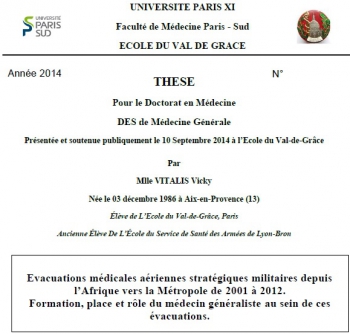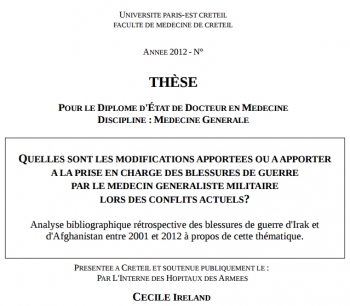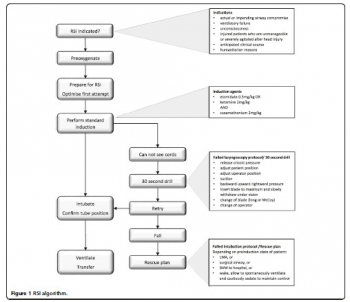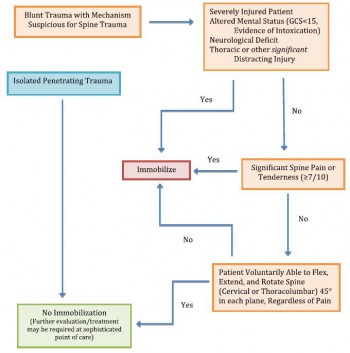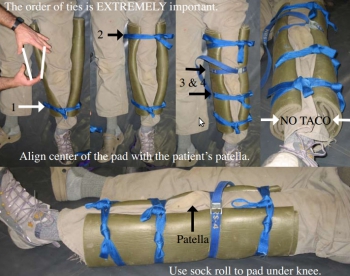10/03/2015
Morphine mieux que kétamine ?
Comparison of the effects of ketamine and morphine on performance of representative military tasks.
Gaydos SJ et Al. J Emerg Med. 2015 Mar;48(3):313-24
---------------------------------------------------------------
Même un militaire blessé peut avoir à recourir à son arme. L'administration d'antalgiques peut interférer avec son niveau de vigilance. La kétamine semble être sur ce point moins maniable que la morphine du moins dans ce travail américain qui fait appel à l'administration intramusculaire, voie qui n'est pas usuelle dans notre pratique.
---------------------------------------------------------------
BACKGROUND:
When providing care under combat or hostile conditions, it may be necessary for a casualty to remain engaged in military tasks after being wounded. Prehospital care under other remote, austere conditions may be similar, whereby an individual may be forced to continue purposeful actions despite traumatic injury. Given the adverse side-effect profile of intramuscular (i.m.) morphine, alternative analgesics and routes of administration are of interest. Ketamine may be of value in this capacity.
OBJECTIVES:
To delineate performance decrements in basic soldier tasks comparing the effects of the standard battlefield analgesic (10 mg i.m. morphine) with 25 mg i.m. ketamine.
METHODS:
Representative military skills and risk propensity were tested in 48 healthy volunteers without pain stimuli in a double-blind, placebo-controlled, crossover design.
RESULTS:
Overall, participants reported more symptoms associated with ketamine vs. morphine and placebo, chiefly dizziness, poor concentration, and feelings of happiness. Performance decrements on ketamine, when present, manifested as slower performance times rather than procedural errors.
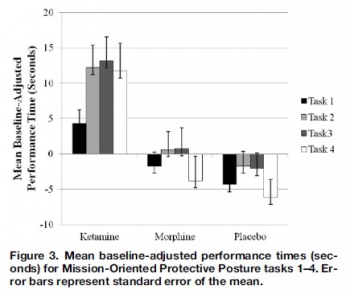
CONCLUSIONS:
Participants were more symptomatic with ketamine, yet the soldier skills were largely resistant to performance decrements, suggesting that a trained task skill (autonomous phase) remains somewhat resilient to the drugged state at this dosage. The performance decrements with ketamine may represent the subjects' adoption of a cautious posture, as suggested by risk propensity testing whereby the subject is aware of impairment, trading speed for preservation of task accuracy. These results will help to inform the casualty care community regarding appropriate use of ketamine as an alternative or opioid-sparing battlefield analgesic.
| Tags : analgésie
Thèse Medevac Africaines
| Tags : medevac
Pansements 3 côtés: C'est efficace
Vented Chest Seals for Prevention of Tension Pneumothorax in a Communicating Pneumothorax
Kotora JG et Al. J Emerg Med. 2013 Nov;45(5):686-94.
--------------------------------------------------------------------------------------------------------------------
La prise en charge d'une plaie thoracique soufflante (1) est une éventualité peu fréquente qui expose d'une part au risque de détresse respiratoire aiguë et d'autre part au risque d'instabilité hémodynamique en rapport avec le caractère compressif d'un épanchement intra-thoracique gazeux ou liquidien (2) L'exsufflation et/ou la pose d'un pansement 3 côtés sont alors requis. Ce dernier peut être réalisé simplement ou par l'emploi de dispositifs commerciaux prêts à l'emploi. Le travail présenté exprime l'efficacité des pansements "3 côtés" de dernières générations aussi bien en matière d'adhérence cutanée que d'efficacité d'évacuation de l'air et secrétions intra-thoraciques. Ils jouent donc ainsi parfaitement le rôle pour lesquels ils ont été conçus (3).
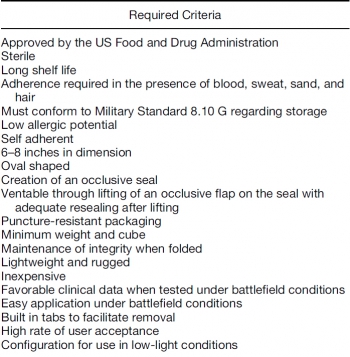
--------------------------------------------------------------------------------------------------------------------
BACKGROUND:
Tension pneumothorax accounts for 3%–4% of combat casualties and 10% of civilian chest trauma. Air entering a wound via a communicating pneumothorax rather than by the trachea can result in respiratory arrest and death. In such cases, the Committee on Tactical Combat Casualty Care advocates the use of unvented chest seals to prevent respiratory compromise.
OBJECTIVE: A comparison of three commercially available vented chest seals was undertaken to evaluate the efficacy of tension pneumothorax prevention after seal application.
METHODS:
A surgical thoracostomy was created and sealed by placing a shortened 10-mL syringe barrel (with plunger in place) into the wound. Tension pneumothorax was achieved via air introduction through a Cordis to a maximum volume of 50 mL/kg. A 20% drop in mean arterial pressure or a 20% increase in heart rate confirmed hemodynamic compromise. After evacuation, one of three vented chest seals (HyFin ®, n = 8; Sentinel ®, n = 8, SAM ®, n = 8) was applied. Air was injected to a maximum of 50 mL/kg twice, followed by a 10% autologous blood infusion, and finally, a third 50 mL/kg air bolus. Survivors completed all three interventions, and a 15-min recovery period.

RESULTS:
The introduction of 29.0 (±11.5) mL/kg of air resulted in tension physiology. All three seals effectively evacuated air and blood. Hemodynamic compromise failed to develop with a chest seal in place.
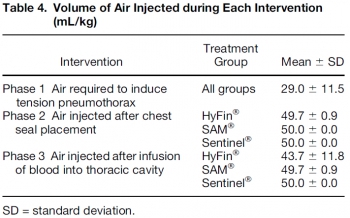
CONCLUSIONS:
HyFin ®, SAM ®, and Sentinel ® vented chest seals are equally effective in evacuating blood and air in a communicating pneumothorax model. All three prevented tension pneumothorax formation after penetrating thoracic trauma
| Tags : pneumothorax, exsufflation
08/03/2015
Annals of burns and fire disasters
Oxygénothérapie: Grands principes
Intérêts et modalités pratiques de mise en route d'une oxygénothérapie
Gut C. et Al. Rev Mal Respir. 2006 Feb;23(1 Suppl):3S13-23
| Introduction |
La mise en œuvre d'une oxygénothérapie lors de la prise en charge d'une insuffisance respiratoire aiguë ou d'une insuffisance respiratoire chronique est un acte médical banal, tout au moins dans les services hospitaliers et les services d'urgences pré-hospitaliers. De même, l'oxygène est utilisé de manière quasi-systématique par des intervenants paramédicaux, en dehors de toute prescription médicale initiale, dans le cadre de pathologies susceptibles de mettre en jeu le pronostic vital.
| État des Connaissances/Perspectives |
Cette mise en route fréquente d'une oxygénothérapie doit toutefois respecter les règles entourant la prescription d'un médicament, dont elle a le statut. Des règles de prescription sont codifiées dans deux situations cliniques précises : l'hypoxie et l'hypoxémie aiguës et chroniques. Il convient pour le praticien d'identifier les signes cliniques en faveur d'une hypoxie avérée et les situations pouvant conduire à une potentielle hypoxémie, afin d'éviter des complications telles que l'arrêt cardiaque hypoxique. De même, le médecin doit être capable de prévenir les complications de l'oxygénothérapie, que celle-ci soit fréquente (comme la survenue ou l'aggravation d'une hypercapnie), ou plus rare (comme la contamination bactérienne des dispositifs d'humidification).
| Conclusion |
Savoir manier l'oxygène revient donc à en connaître les indications, les complications et effets secondaires, ainsi que les modalités pratiques d'administration.
| Tags : oxygène
Brûlés et transport aérien
Transport aérien longue distance des brûlés graves: Revue de la littérature et application pratique
Leclerc T. et Al. Annals of Burns and Fire Disasters - Pending Publication
Les brûlés graves nécessitent une prise en charge multidisciplinaire dans descentres hautement spécialisés. La rareté de ces centres impose souvent le transport aérien médicalisé longue distance. Cependant, il y a peu de données publiées sur ces transferts. Dans cette mise au point, pour optimiser la prise en charge des brûlés dès qu’un transport aérien est décidé ou même seulement envisagé, nous proposons d’extraire de cette littérature limitée des principes simples s’appuyant aussi sur l’expérience pratique du Service de Santé des Armées françaises. Nous décrivons d’abord comment les contraintes aéronautiques peuvent affecter le transport de brûlés graves à bord d’aéronefs. Nous abordons ensuite la régulation de ces missions, en analysant les risques associés au transport aérien des brûlés graves et leurs implications sur les indications, la chronologie et les modalités du transport. Enfin, nous développons la conduite de la mission, comprenant la préparation du matériel et des consommables avant le vol, l’évaluation et la mise en condition du patient avant l’embarquement, et la poursuite de la prise en charge en vol
| Tags : brûlure
Blessures de guerre: Perspectives de modification de la prise en charge
07/03/2015
Évacuations aéromédicales: Que fait le SSA, l'expertise africaine ?
Mise en place du TCCC: Le point 2014
| Tags : tccc
06/03/2015
Mise en place du TCCC: Le point 2013
| Tags : tccc
Intubation préhospitalière: Être conscient du temps qui passe
Implementing new advanced airway management standards in the Hungarian physician staffed Helicopter Emergency Medical Service.
Soti A; et Al Scand J Trauma Resusc Emerg Med. 2015 Jan 9;23(1):3.
Parmi tous les risques qui peuvent être rencontrés en médecine d'urgence, il y a l'effet tunnel. Vouloir à tout prix réussir un geste et oublier pourquoi. L'article présenté introduit insiste sur l'importance d'appliquer un algorithme et d'en respecter touts les phases. Par exemple la notion du temps lors de la réalisation de la première laryngoscopie est importante.
clic sur l'image pour accéder au document
| Tags : airway
03/03/2015
Stabilisation du rachis: C'est particulier en milieu hostile
Recommandation 1 (grade:1C) :
Neutral alignment should be restored and maintained with light or moderate manual cervical traction during extrication, unless such a maneuver is met with resistance, increased pain, or new or worsening neurologic deficit.
Recommandation 2 (grade:1C):
Patients requiring extrication, when the cervical spine cannot be cleared before extrication, should be placed in a cervical collar and allowed to exit the situation under their own volition if alert and reliable. Otherwise extrication should be performed with a KED (or similar device) plusc ervical collar,and the immobilized patient moved in a sitting position onto a long spine board, vacuum mattress, orsimilar device.
Recommandation 3 (grade:1C):
The lift and slide transfer with trap squeeze is preferred to the log roll when transferring patients to and from a backboard
Recommandation 4 (grade:2C):
Spinal immobilization should be considered in patients with evidence of spinal injury, including those with neurologic injury, and those patients who have experienced severe trauma and are unconscious or exhibit altered mental status.
Recommandation 5 (grade:2B):
The cervical collar (or improvised equivalent) should beconsidered one ofs everal tools available to aid in immobilization of the cervical spine. It should not be considered adequate immobilization in and of itself, nor should it beconsidered necessary if adequate immobilization can be accomplished by other means, or if the presence of the collar in itself compromises emergent patient care.
Recommandation 6 (grade:1B):
Use of the cervical collar is contraindicated in ankylosing spondylitis. Patients with suspected injury should hav etheir neck supported in a position of comfort
Recommandation 6 (grade:1C):
Vacuum mattress provides superior immobilization, with or without a standard cervical collar, and improved patient comfort (with corresponding decreased risk of pressure sores) and is preferred over a backboard for immobilization of either the entire spine or specific segments of concern.
Recommandation 6 (grade:1A):
Appropriately trained personnel, using either the NEXUS criteria or the Canadian C- spine rule, can safely and effectively make decisions in the prehospital setting about whether or not ac ervical spine should be immobilized.
Recommandation 7(grade:1B):
Spinal immobilization should not be performed in the presence of penetrating trauma
Clic sur l'image pour accéder au document
| Tags : rachis, immobilisation
Tapis de sol: Pour immobiliser
| Tags : immobilisation

